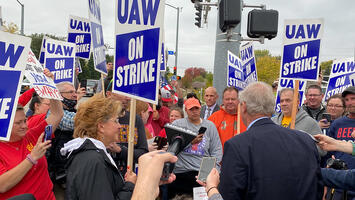
As we await U.S. Senate action on President Biden’s Build Back Better plan, it is worth reflecting on what the past few tumultuous months have meant for U.S. workers. Much has happened in the short time since the summer drew to a close. Collective and individual actions have worked together to create new leverage for both organized and unorganized workers that didn’t exist six months ago. Workers are expressing higher levels of discontent than we have seen in years. And the federal government has taken a more pro-worker and even pro-union stance than most living Americans have ever seen before.
To begin with, an unprecedented number of workers have quit their jobs in what we have taken to calling the “Great Resignation.” A record 4.3 million workers quit their jobs in August, according to the aptly named JOLTS (Job Openings and Labor Turnover Summary) survey. Many economists predicted that number would decline in September as children returned to in-person school, relieving working parents from the difficult balancing act they had maintained during the pandemic, when managing online schooling forced many, especially women, to leave their jobs. Instead, workers broke the record again in September as 4.4 million quit. The unprecedented willingness of workers to say “Take This Job and Shove It,” as the old David Alan Coe song put it, has produced something rare in U.S. history: a worker-created labor shortage that has hit sectors that offer low wages (like fast food) and terrible working conditions (as in trucking) especially hard. Plenty of people who could flip burgers or who hold trucking licenses are choosing not to.
Workers’ increasing willingness to quit bad jobs has in turn strengthened the hands of unionized workers, who have decided to take advantage of this moment to stage walkouts. A spate of strikes at John Deere, Nabisco, Kellogg’s, and Alabama’s Warrior Met coal company, among others, led observers to coin a new portmanteau — “Striketober.” The last U.S. strike surge happened in 2018, when more workers went on strike than in any year since the mid-1980s. But that surge was driven almost entirely by public sector workers. Almost 80% of strikers in 2018 were teachers, #RedforEd strikers in West Virginia, Arizona, and other states, or the “Bargaining for the Common Good” strikes led by the big teachers’ unions in LA and Chicago. Private sector workers sat out the 2018 strike wave. Since Ronald Reagan famously broke the 1981 air traffic controllers strike, the strike rate among private sector workers has continuously declined. In 2020, there were only eight major work stoppages in the US (down from a postwar high of 470 in 1952)—and only two of those involved the private sector.
While the recent “strike wave” is tiny in comparison to past instances of worker militancy, it reveals a growing discontent among workers that may just begin to rouse unions out of the defensive crouch they have been in recent years. John Deere strikers twice rejected tentative agreements between their union, the United Auto Workers, and management before finally agreeing to a contract that included an immediate 10% wage hike. After rejecting a tentative agreement with their university after a monthlong strike in the spring, members of the Columbia University graduate workers union walked out again on November 3. Perhaps most significantly of all, the 1.4 million-member Teamsters union recently chose new leadership. By an overwhelming 2-1 margin, Sean O’Brien and Fred Zuckerman defeated Steve Vairma and Ron Herrera for the Teamster’s top offices after running a campaign that criticized the leadership of outgoing president James Hoffa as too business-friendly.
But the change isn’t just happening among workers. The federal government has taken some remarkably pro-worker actions lately compared to those of administrations of either party over the past half-century. In successive weeks in October, Secretary of Agriculture Tom Vilsack visited a John Deere picket line in Iowa, and Secretary of Labor Marty Walsh joined Kellogg’s strikers in Pennsylvania. For decades before this, even putatively pro-union cabinet members embraced neutrality during strikes, as Bill Clinton’s Secretary of Labor, Alexis Herman, did during the 1997 UPS strike, when she demanded that “everyone involved must show greater flexibility and willingness to compromise.”
Read the rest of this piece at Working Class Perspectives.
Joseph A. McCartin is Professor of History and Executive Director of the Kalmanovitz Initiative for Labor & the Working Poor at Georgetown University.
Photo: USDA via Flickr in Public Domain.












